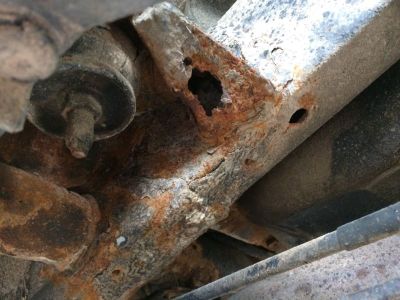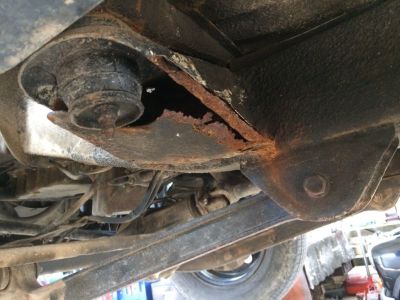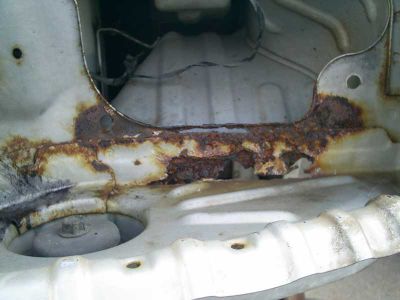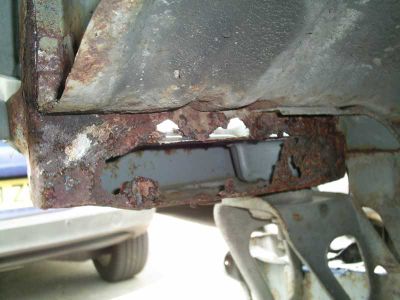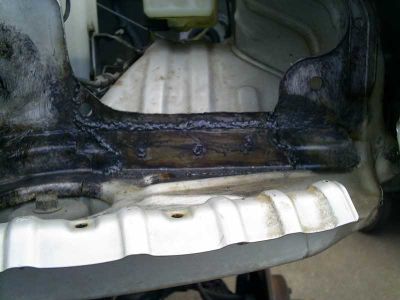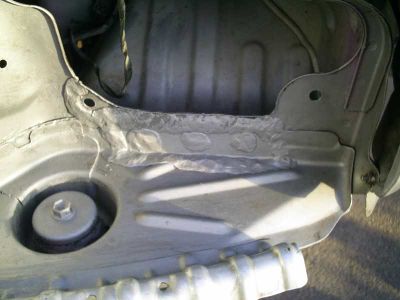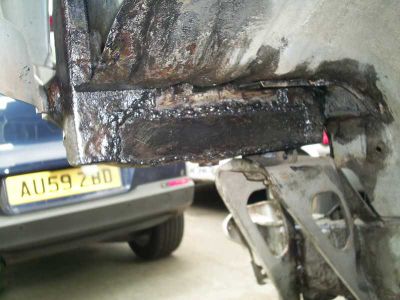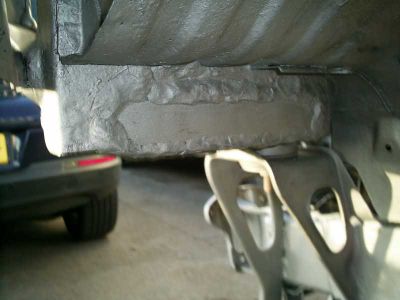![]() The content of any article might be expanded / improved in the future - revisit it sometimes.
The content of any article might be expanded / improved in the future - revisit it sometimes.
![]() Seen a mistake? Know something that isn't written? Edit and change this article yourself!
Seen a mistake? Know something that isn't written? Edit and change this article yourself!
![]() Some images in the article (if present) can be enlarged by clicking on them.
Some images in the article (if present) can be enlarged by clicking on them.
Contents
- 1 Introduction
- 2 Death wobble vibrations
- 3 Vacuum system for front wheel hub heads
- 4 King pin bearing wear out
- 5 R-U-S-T
- 6 Gearbox failures
- 7 Constant velocity joint wear out
- 8 Engine issues
Introduction
Here is a quick overview of common problems which a Jimny owner might encounter. Some of them have their own dedicated wiki articles.
Death wobble vibrations
This problem is quite common on Jimny 3. Due to very similar suspension design, it is expected (but not yet observed as of 2019) to be a common occurrence on Jimny 4 too.
Short explanation
- The name of this vibration phenomenon is quite fitting to its manifestation. You'll understand it if you experience it.
- It's a jargon name for (usually) severe vibrations of the steering wheel and even entire front half of the vehicle in a specific speed range.
- This is the nastiest experience to encounter, and sometimes the most difficult issue to resolve (on the other hand, sometimes it is trivial to resolve).
Solutions
- Read the wiki article "Death wobble" for the full explanation and for the step-by-step guide on diagnosing it and resolving it.
Vacuum system for front wheel hub heads
Short explanation
- The front wheel hub heads / caps connect the road wheel assembly to the transmission (to the constant velocity joint).
- Most vehicles with part-time 4WD transmission (like the Jimny) have (un)lockable front wheel hub caps (so they are essentially a sort of a clutch), which can (dis)connect the road wheel hub assembly to/from the transmission (the CV joint).
- When the wheel hub assembly is disconnected from the transmission, the driving force in the transmission does not get applied to that wheel.
- This saves fuel and mechanical wear in the front transmission section when vehicle is operating in 2WD (RWD) transmission mode.
![]() Wheel hub heads / caps are usually just shortened in naming to "hubs", but a "hub" is actually an entire wheel hub assembly - the casing which contains the wheel bearing with its seals, the steering knuckle surround casing, the king pin bearings and (in the case of the Jimny) the pipes and passages which transport the air / vacuum to/from wheel hub heads.
Wheel hub heads / caps are usually just shortened in naming to "hubs", but a "hub" is actually an entire wheel hub assembly - the casing which contains the wheel bearing with its seals, the steering knuckle surround casing, the king pin bearings and (in the case of the Jimny) the pipes and passages which transport the air / vacuum to/from wheel hub heads.
- There are three typical operating designs of (un)lockable wheel hub heads - with a manual hand switch, with an automatic spring mechanism, or vacuum operated.
- Jimnys use vacuum operated front wheel hub caps.
- Jimnys, which have or have had a hard life, have a higher tendency to develop a vacuum leak in their vacuum system for front wheel hub caps.
- When the system is "leaking vacuum" the (dis)engagement of front wheel hub caps is erratic or impossible, and that directly affects the operation of 4WD transmission.
- If you are unlucky enough, this can render your vehicle motionless in slippery or off-road conditions.
Solutions
- Read the wiki article "4WD transmission failure diagnostics" for a step-by-step guide on diagnosing the cause of the fault / leak in your vacuum system.
- Read the wiki article "Manual or fixed front wheel hub heads" if you want to get rid of the vacuum system and enjoy a much more robust solution.
King pin bearing wear out
This problem is quite common on Jimny 3. Due to very similar suspension design, it is expected (but not yet observed as of 2019) to be a common occurrence on Jimny 4 too.
Short explanation
- The front wheel hub assembly rotates left-right (when steering) on a pair of king pin bearings, which connect the front wheel hub assembly to the front axle casing.
- Each front wheel hub assembly is held on to the front axle casing by two king pin bearings, a bottom one and a top one.
- Due to Jimny's relatively poorly designed steering knuckle assembly, there is a tendency for water, mud, dust and grit to enter the steering knuckles and then get into the king pin bearings.
- This can rapidly accelerate the wear of the king pin bearings, especially the of bottom one.
- Worn out king pin bearings can cause several issues, and the nastiest one is the "Death wobble".
Solutions
- Some heavy-duty water proof and nuclear proof grease in and on the king pin bearings can aid to deter the pollutants, but there is no absolute defense.
- Try to avoid deep water and deep mud - if you want to roll in it like a pig on a regular basis, then use an all-terrain vehicle which is 3-5x more expensive than a Jimny (Defender, G-Class, Land Cruiser, Patrol, Wrangler ...).
- Otherwise, learn by heart the wiki article "King pin bearing change" for a step-by-step guide on how to replace the king pin bearings.
R-U-S-T
General info
All Jimny generations have particularly poor rust prevention treatment applied from the factory. Combine that with typically harsher uses of these vehicles compared to ordinary road cars, and the typical outcome is a "rust bucket". However, most of these "rust buckets" are not obviously visible, unless you make a good crawl under the vehicle, take the rear seats or the front carpet out, or at least empty the boot.
Read the wiki article "Rust protection" for much more details and plenty of pictures, as well as generic and specific advice on preventing and/or combating rust.
Typical rusty points on all Jimny generations are:
- Body (cabin) and suspension carriers (mounting points) on the chassis
- Various factory welding points on the chassis and on the axles as well
- Boot / trunk floor
- Below the rear seats
- Inner wheel arches
- Bodywork behind the side plastic mouldings (claddings)
- Bodywork behind front driving lamps
These forum topics deal (at least in part) with rust in Jimnys:
Rust in the boot (trunk) floor and below rear seats
Short explanation
- Jimnys which have or have had a hard life tend to develop rust in the boot (trunk) floor area and sometimes below the rear seats.
- Rust usually begins from the holes in the floor through which the rear seat belts are anchored to the floor, and sometimes also from the holes in the floor through which the rear seats are anchored to the floor.
- Rust also tends to thrive in the body cavities behind/below rear vertical lamps (behind the rear seat belt winders) and from there it extents into the boot floor.
Solutions
- In UK, there are aftermarket-made pressed-out steel sheets of the same shape as the trunk floor and the rear seat floor, which enable a quick replacement of the rusted area by cutting it out completely and then welding on the entire new floor section.
Rust in the underbody
Short explanation
- Rust tends to develop in the underbody, especially on the chassis mounts for vehicle's body, on the chassis mounts for coil springs, and around many factory welds on the chassis.
- Rust in chassis mounts for vehicle's body and coil springs can present a critical vehicle structural failure!
- It also tends to develop on the body from underneath (read the chapter about rust in the trunk and below rear seats).
- An example of a severely corroded Jimny 3 underbody. The vehicle was 10 years old with only 60 000 km on the odometer, mostly on paved, salty alpine roads!
Solutions
- This issue is best preventively dealt with - rustproofing the underbody while it is still in very good condition.
- Do not wait for the rust to develop first!
- If there is already some rust present, it should be thoroughly (100,0000000000000000%) eliminated before applying any rust proof coating.
- If the chassis elements are already severely corroded, the vehicle might be rendered unfit for use, and impossible to repair.
Rust behind front head lamps
Short explanation
- This is another typical area of a Jimny which rusts.
- The manufacturer simply did not apply sufficient rust protection in this vulnerable area during manufacturing.
- A standard example of rust behind the head lamps.
Solutions
- This area should be preventively rust-proofed, or at least cleaned from existing rust and then thoroughly rust proofed before it gets completely eaten away by rust.
- Otherwise, get ready to weld steady!
- Significant welding effort is required to properly repair the rust in the tricky place behind the head lamps.
Rust under the plastic side body cladding
Short explanation
- Older Jimnys, or especially those who have or have had a hard life, tend to develop rust on their bodywork which is hidden behind plastic body claddings / moldings.
- That means the bottom of the doors and especially the wheel arches.
- That is no surprise because those claddings naturally contain moisture for much longer than it would have been without them.
- The problem is that this is usually invisible until very late stages of decomposition, because it is hidden by those plastic claddings.
Solutions
- If you want to assure the longevity of your vehicle, it might be a good idea to strip down those plastic claddings and then clean and additionally rustproof the metal panels behind them.
- You can return the claddings back onto the vehicle once the rustproofing has been finished.
Gearbox failures
Short explanation
- Some petrol Jimnys made in mid-to-late 2000s have a gearbox model "R72" which is known for its relative tendency to fail prematurely.
- The main cause of failure is in some bearings inside the gearbox.
Solutions
- Read the wiki article "Gearbox R72 rebuild" for the full explanation and a step-by-step repair procedure.
- If the gearbox is repaired properly with better bearings, the repair should be quite a long lasting one.
Constant velocity joint wear out
This problem is common on Jimny 3. Due to very similar transmission design, it is expected (but not yet observed as of 2019) to be a common occurrence on Jimny 4 too.
Short explanation
- Constant velocity joint connects the transmission halfshaft in the front axle to the road wheel assembly.
- Thus, the joint transfers driving force from the differential to the wheel.
- The joint enables the transmission of the same driving force under any angle in its operating range (the angle changes when the wheel steers left-right).
- The failure of a CV joint is not a common problem on Jimnys per se, but it is mentioned here for several reasons.
- Reason 1: It is easy to damage a CV joint by using Jimny's 4WD transmission improperly on a surface which is not slippery (enough).
- This is not vehicle's design fault, but typical "user error".
- Reason 2: It can be very expensive to repair, because Suzuki sells only the entire "CV joint + halfshaft" assembly, which costs in excess of 1000 EUR / USD / GBP / kidneys on its own!
- Reason 3: The choice of aftermarket CV joint replacements for newer Jimny revisions (cca year 2006+) is very poor - only one or two aftermarket manufacturers!
- In newer Jimnys with push-button 4WD transmission controls, the 4WD mode can sometimes be accidentally (inadvertently) engaged in the middle of on-road driving or (even worse) when parking (when operating nearby controls on the dash board, or just when cuddling, kissing, wrangling or fighting in the vehicle).
- There is a high risk of damage to the CV joint or some other transmission elements if the inadvertent engagement of 4WD mode is not immediately noticed and remedied.
Solutions
- Read the wiki article "CV joint replacement" for the step-by-step guide on replacing a CV joint.
- Read the wiki article "DO's and DON'T's with Jimnys" to learn how to evade the need to read the previous article in the first place.
Engine issues
Short explanation
Petrol Jimny 3:
- The older G13BB petrol engine and the newer M13A (with and without VVT) petrol engine are generally very robust and rarely develop any mechanical issues (if maintained properly).
- Those petrol engines can occasionally develop issues with various sensors or electrics (spark plug leads, camshaft or crankshaft sensors, coolant temperature sensor, O2 sensor, etc.), but those issues are relatively easy to diagnose through a relatively quick step-by-step elimination procedure.
Diesel Jimny 3:
- The older K9K 700 (non-intercooled) diesel engine is statistically very troublesome and has several very serious potential issues.
- The newer K9K 266 (intercooled) diesel engine is much less prone to catastrophic failures than the older engine.
- However, both diesel engines, being a high-tech common rail diesel and being turbocharged, are much more complex than the petrol engines, and therefore statistically are more risky.
Petrol Jimny 4:
- It is still early as of 2019 to tell about any common engine issues ...
Solutions
- Issues with sensors or electrics on petrol engines can be searched for in various forum topics.
- There is currently no dedicated wiki article which deals with those issues.
- Both K9K diesel engine models have to be both maintained and driven with more care in order to maximize their reliability expectation.
- Read the wiki article "Diesel (DDiS) Jimny specifics" to learn in detail about various common issues with diesel engines, as well as about those preventive maintenance actions and driving behavior for the best care of those engines.
Page last edited on 4/03/2021 by user Bosanek

